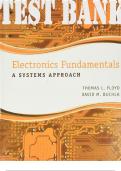,Chapter 1: Systems, Quantities, and Units
MULTIPLE CHOICE. Choose the one alternative that best completes the statement or answers the question.
1) A plot of the ratio of the output of a circuit to the input is called a 1)
A) gain transfer B) block diagram
C) transfer curve D) conductance ratio
2) The electrical symbol for voltage is _. 2)
A) R B) C C) V D) I
3) Express 7.5 × 10-4 in milli, basic units, and micro. 3)
A) 75 milli, 0.0075, 750 micro B) 7.5 milli, 0.075, 75000 micro
C) 75 milli, 0.075, 7500 micro D) 0.75 milli, 0.00075, 750 micro
4) The difference between electrical and electronic systems is 4)
A) one is analog and the other is digital
B) the voltage levels
C) there is no major difference other than terminology
D) electrical deals with power while electronic deals with signals
5) Determine the correct calculation. 5)
A) 5.6 ÷ 17 m = 32.9 m B) 89.4 k × 1.2 m = 1.072 km
C) 5600 × (9.6 × 10-7) = 5.376 milli D) 4.7 m ÷ 1.24 = .379 m
6) The combining of skills from mechanical and electronic disciplines is called 6)
A) mechatronics B) integrated learning
C) horizontal integration D) vertical integration
7) A model of a complex electronic system is often simplified and represented as a 7)
A) timning diagram B) flow chart
C) block diagram D) logic ladder
8) If your calculator displays 3.45607 × 106, the equivalent metric value with 4 significant digits is 8)
.
A) 3.456 micro B) 34.56 Mega C) 3.456 Mega D) 3.456 kilo
9) The metric value 16 mA can be expressed as . 9)
A) 16 × 10-3 A B) 16 × 10-6 A C) 16 × 100 A D) 16 × 103 A
10) The value 1.2 × 10-6 can be expressed as . 10)
A) 1.2 M or Meg B) 1.2 m or milli C) 0.00012 D) 1.2 µ or micro
11) The symbol for electrical charge is . 11)
A) C B) I C) V D) Q
1
,12) Multiply 3 mA by 1000 × 10-6 and express the result in microamperes. 12)
A) 300 µA B) 3 µA C) 30 µA D) 3000 µA
13) Convert 0.00047 microfarads (µF) to the equivalent picofarads (pF). 13)
A) 0.47 pF B) 4.7 pF C) 470 pF D) 47 pF
14) Express 5.6 × 10-2 in milli, basic units, and micro. 14)
A) 5600 milli, 56, 560 B) 5.6 milli, 0.056, 56000 micro
C) 560 milli, 5.600, 5600 micro D) 56 milli, 0.056, 56000 micro
15) Express these two calculator displays in correct metric units: 15)
5.6 - 07 2.2 05
A) 0.56 micro, 220 kilo B) 56 micro, 220 kilo
C) 56 micro, 22 kilo D) 0.56 micro, 0.022 Meg
16) 500 mA is equal to . 16)
A) 0.5 Amps B) 0.0005 kA C) 500,000 µA D) all of the above
17) The correct metric expression for 8.54 × 10-5 is _ . 17)
A) 854 pico B) 85.4 micro C) 85.4 milli D) 85.4 kilo
18) Signals that vary continuously are called 18)
A) oscillators B) digital signals C) analog signals D) active circuits
19) If you are trying to enter the number 16,000 into your calculator, a correct entry is . 19)
A) 1.6 04 B) 1.6 05 C) 1.6 02 D) 1.6 03
20) Add 21 mA and 8000 µA and express the result in milliamperes. 20)
A) 21.8 mA B) 290 mA C) 218 mA D) 29 mA
21) Pico is what relation to micro? 21)
A) 1/10th B) 1/100th C) 1/1,000th D) 1/1,000,000th
22) The metric prefix µ (micro) is normally associated with measurements. 22)
A) large B) extremely small
C) small D) extremely large
23) 0.6 kV is equal to _. 23)
A) 6 V B) 600 V C) 0.6 V D) 60 V
24) To enter 0.00000056 into your calculator, use the entry . 24)
A) 5.6 -08 B) 00056 -05 C) 56 -06 D) 56 -08
25) If your calculator displays 3.5 - 06, the equivalent metric value is . 25)
A) 35 milli B) 3.5 pico C) 35 micro D) 3.5 micro E) 3.5 Meg
26) 86,000 expressed in scientific notation equals _. 26)
A) 860 × 102 B) 8.6 × 10-4 C) 8.6 × 103 D) 8.6 × 104
2
, 27) Any component that requires a source of power to function is called 27)
A) a load B) a source
C) an amplifier D) an active component
28) The difference between scientific and engineering notation is . 28)
A) groupings of multiple of three digits
B) single vs multiple digits before decimal point
C) powers of ten representation
D) all of these
29) Mega is what relation to kilo? 29)
A) 10 times B) 100 times C) 1000 times D) 1,000,000 times
30) The electrical symbol for inductance is _ . 30)
A) I B) C C) V D) L
TRUE/FALSE. Write 'T' if the statement is true and 'F' if the statement is false.
31) 0.0047 amps can be expressed in engineering notation as 47 µA. 31)
32) Vertical organization is more specialized than horizontal organization 32)
33) 0.00015 can be expressed in powers of ten as 1.5 × 10-4. 33)
34) The first step in designing a circuit is to build it using design software. 34)
35) AC is often converted to DC with a power supply 35)
36) In engineering notation, 82,500 is expressed as 8.25 × 103. 36)
37) A boundary defines the dividing line between a system and everything else. 37)
38) The symbol µ is an abbreviation for 10-6 or micro. 38)
39) Scientific notation is the most widely used form of technical notation in electronics. 39)
40) Engineering notation is typically used in the expression of extremely large and small quantities in 40)
the electronics field.
41) In engineering notation 0.0047 is expressed as 4.7 × 10-3. 41)
3




